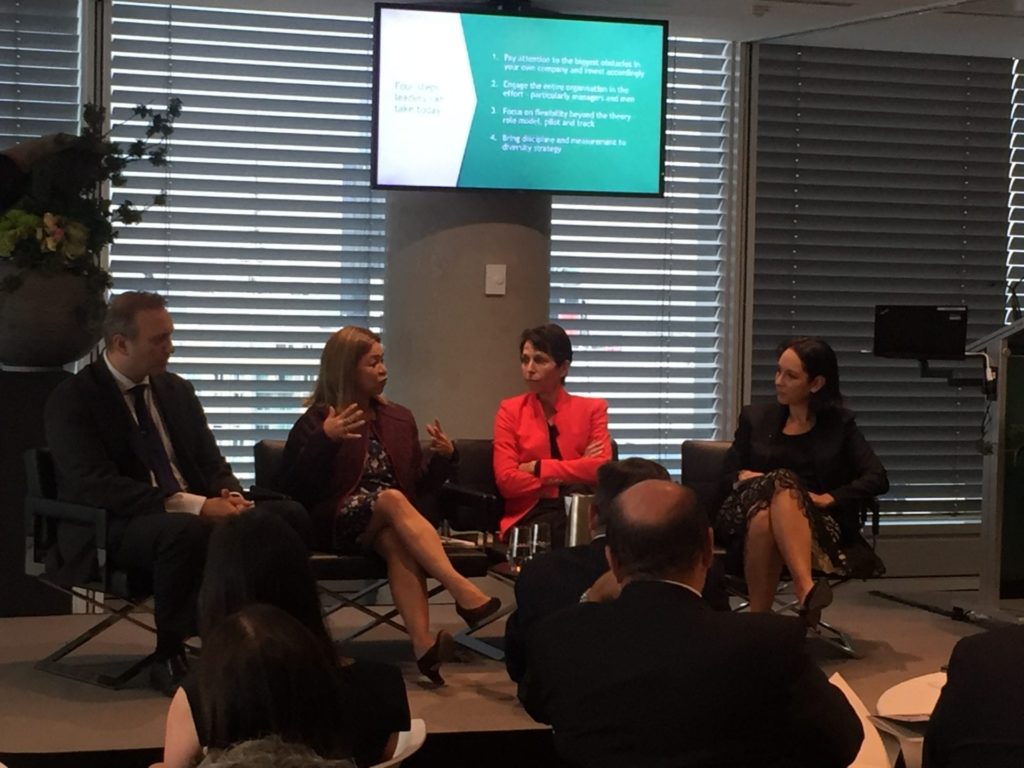Jayne never had that conversation, and instead opted for a different one: telling her superiors upon taking on the role that she wouldn’t be spending significant chunks of time away from home, and that she’d continue to drop her kids to school when she was in Melbourne.
Speaking this morning at the launch of the Boston Consulting Group’s new report, What’s Working to Drive Gender Diversity in Leadership, Jayne said a commitment to flexible work can drive gender diversity in leadership.
She spends just three nights away from home on her regular trips to Asia (two of them on a plane), instead of the two weeks preferred by her predecessor. And she manages to make it home to help her kids with home work and attend their school functions.
Jayne shared the example of how she works to demonstrate that even CEOs and senior managers can work flexibly, but a greater challenge may exist in ensuring other staff (particularly those working shifts) can access schedules that work for them. “We need to give employees a sense of control on how they manage,” she said. “Management is the easiest part. I knew I could just role model and demonstrate it myself.”
The BCG report found there’s a disconnect between where organisations are investing in gender diversity, and the challenges cited as the key impediments to progress: retaining and promoting high potential women.
Flexibility came up central to driving gender diversity with four of the ten most effective interventions identified relating to flexibility: including informal flexibility, part-time working role models, general flexibility and on-site childcare.
Attending the launch of the report at BCG’s Sydney headquarters, it was encouraging to see a number of CEOs of major organisations, as well as senior HR and diversity leaders, in the room.
It was also encouraging to hear BCG’s verdict: that Australian organisations are increasingly acknowledging the importance of gender diversity. They get the business case for gender diversity, many are willing to seriously invest in addressing the issue, the problem is that we’re not seeing a whole lot of success at the pointy end of leadership.
CEO positions continue to be overwhelmingly occupied by men – just look at the ASX 200 where women will soon occupy just eight of such positions, and the gender gap in the Australia workforce gets wider with seniority.
Joining Jayne from Jetstar on the panel to further explore the BCG findings were ABC boss Michelle Guthrie and PepsiCo boss Robbert Rietbroek, as well as Anna Green, partner and managing director of BCG Sydney.
Michelle shared some of her own personal experiences climbing the leadership ladder, often being one of very few leaders in the room in her previous role at Google. She said there are things holding women back that “guys don’t always compute” and admitted that she had previously held back from applying for a role because she didn’t believe she was 100% qualified.
Robbert shared some examples of what’s working to drive staff engagement in his organisation, especially a number of policies like ‘Leaders Leaving Loudly’, which encourages staff to be open and frank about why they’re leaving the office early.
He also warned leaders about not measuring progress on diversity initiatives. “Having a policy doesn’t mean we are affecting change,” he said.
The report makes for worthwhile reading. The money available to support women in leadership is obviously limited, and many organisations may be investing it in the wrong places, with little to return. A good start, found the report authors, would be for companies to spend more time actually listening to the very people their gender diversity initiatives are designed to help. It found that companies need to move “beyond basic inclusiveness and policy-driven” measures to address what women are deem as the real obstacles to progress.
BCG outlined three key opportunities to consider when evaluating a company’s diversity strategy:
- Focus effort and investment on the biggest challenges facing women today – removing obstacles to career advancement and retention: This includes identifying and investing in retaining talent; increasing senior sponsorship; and increased focus on the development experiences needed for women to succeed in the next role.
- Invest in what is already working – ensure the viability and visibility of flexible work models: Employees identified flexible work arrangements as the most important prerequisite to fostering gender diversity; ensuring senior role models take up flexible work options, amongst other measures, will help embed flexible working.
- Approach diversity strategy with the same level of enthusiasm and rigour as any other business strategy: Often the downfall is execution. This can be improved with commitment from leadership, engaging the entire organisation and having a test-and-learn mindset.


